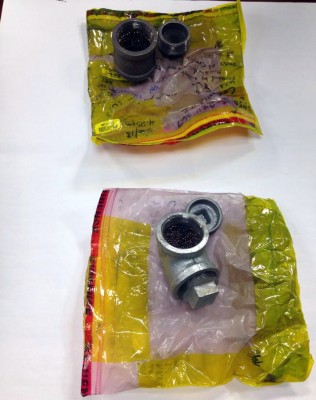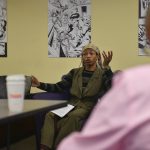Tuesday and Wednesday marked days eight and nine of testimony in the trial of Dzhokhar Tsarnaev, the 21-year-old who allegedly, with his deceased older brother Tamerlan, placed two bombs at the finish line of the Boston Marathon on April 15, 2013. The bombs killed three and injured more than 260. He is pleading not guilty to all 30 federal counts for which he is being tried.

On Tuesday morning, the younger Tsarnaev’s childhood friend Stephen Silva took the stand.
The 21-year-old is allegedly responsible for providing Tsarnaev with the handgun used in the murder of Massachusetts Institute of Technology Police Officer Sean Collier on April 18, 2013. Silva took the stand after a brief examination of David Henneberry, the owner of the Watertown boat that Tsarnaev had allegedly been hiding in before being taken into custody.
Silva said he has known the defendant since the eighth grade and they were close in high school.
In high school, Tsarnaev and Silva were both enrolled in a class that allegedly debated whether or not terrorism is justified. Silva said Tsarnaev often participated in these debates.
“At this point in class, I remember we were having a debate about American foreign policy in the Middle East … the defendant raised the point that American soldiers and American foreign policy tend to be hostile towards the Middle East and Muslims … and Americans shouldn’t be able to go wherever they want and force people to believe what they don’t want to believe,” he said.
After graduating from high school, Silva and the defendant still spoke almost every day during their first semester in college. He said he and Tsarnaev talked about usual topics — how the first semester was going, girls and partying.
After a brief stint in Tampa, Florida, Silva moved back to Boston in late 2012. He, his brother and his good friend Nick considered purchasing a firearm for protection.
It was around this time that Silva’s friend, Howie, had been looking for someone to take his P95 Ruger handgun for a few weeks. Silva offered to help out and stored the handgun and 10 rounds of ammunition in a ceiling tile in his apartment.
“The gun was black. It kind of looked a little rusty … It said P95 on the top side,” he said. The serial number had also allegedly been “obliterated” before Silva received the gun, according to Silva.
It wasn’t until later, Silva said, that Tsarnaev became interested and asked for the gun. Silva agreed and gave Tsarnaev the gun and 10 rounds of ammunition.
“I remember him saying something like, ‘food for the dog,’” Silva said of the defendant’s reaction to being given the ammunition.
Silva said he only visited Tsarnaev’s home once during their friendship. He identified photos of Tsarnaev’s room, desktop computer and a black flag with Arabic writing on the bedroom wall for the jury.
When Howie asked for his gun back, Tsarnaev held out.
“He just kept coming up with excuses [as to why he couldn’t give the gun back]. He was beating around the bush,” Silva said.
Silva last saw Tsarnaev before the marathon bombings in early April 2013, when Tsarnaev bought marijuana from him.
When Silva saw surveillance videos of Tsarnaev in the Shell Station across from his mother’s apartment complex the night of Collier’s murder, he was taken aback.
“I was in a state of huge shock, disbelief, paranoia. I did nothing … I didn’t really want to talk to people. I didn’t really want to go outside. I stopped selling,” he said.
In the cross-examination, defense attorney Miriam Conrad focused on Tamerlan Tsarnaev’s influence on his younger brother, the Associated Press reported Tuesday.
“‘He said his brother was very strict … very opinionated, and that since I wasn’t a Muslim, you know, he might give me a little [expletive] for that,’” Silva said, the AP reported.
Silva said he hadn’t previously heard the defendant make any anti-American comments, the AP reported.
Silva is currently housed in a correctional facility for crimes including the possession and intent to distribute heroin, as well as for the possession of a handgun with an obliterated serial number. His cooperation with the U.S. government in the Tsarnaev trial could lead to a shortened sentence of five to seven years, as opposed to his proposed sentence totaling about 160 years in prison. He has pled guilty to all the charges against him.
Wednesday’s proceedings focused on evidence recovered from the standoff and manhunt for the Tsarnaev brothers that occurred in Watertown in the days following the Marathon bombings.
First, the prosecution called to the stand Massachusetts State Police Trooper Robert McCarthy, part of the state police’s bomb squad. McCarthy’s testimony focused on the potentially explosive items found on Laurel Street and in the Mercedes-Benz SUV that was considered a suspect vehicle.
On the night of April 18, 2013, McCarthy said he received calls about a carjacking in the Cambridge and Watertown area.
“They’re throwing bombs at us. We need the bomb squad,” McCarthy recalled police officers in the Watertown area saying.
Upon arriving in Watertown in the bomb squad truck, McCarthy said he “heard a loud pop” and saw smoke rising nearby.
McCarthy exited the truck, but returned once he heard the sound of gunfire. At this point, McCarthy said “everyone” was calling for the bomb squad.
After investigating a suspicious-looking cardboard box on Mt. Auburn Street, McCarthy received reports of potentially live devices in the Laurel Street roadway, where one of the suspect vehicles, a green Honda Civic, remained.
McCarthy said two undetonated pipe bombs were recovered and transported via trailer containment vessel to the Boston Police Department’s gun range at Moon Island.
On April 19, 2013, McCarthy and the bomb squad were called to the intersection of Spruce and Lincoln Street after police found “a Tupperware box that had a fuse coming out of it” in the Mercedes, which had been abandoned by the defendant.
The Tupperware container was placed onto the street and the lid was pulled off on site, revealing “two to three pounds” of explosive powder and a bundle of hobby fuse.
At Moon Island on April 20, 2013, the two homemade pipe bombs recovered on Laurel Street were rendered safe and further examined.
One of the devices featured a curved “elbow” pipe, which McCarthy said is more dangerous than a traditional pipe bomb because it doesn’t roll away.
“I typically call this an improvised grenade,” he said.
Both devices were lined with BBs and filled with a “large” amount of explosive powder. Hobby fuse was used to potentially ignite the explosive powder found inside the pipes.
McCarthy said he noted a “scorching burnt mark” at the end of the hobby fuse attached to the more traditional-looking pipe bomb.
All three devices were presented to the jury as evidence.
A brief cross-examination clarified that McCarthy had not personally witnessed an explosion in the Watertown area.
“We didn’t see it [the explosion],” McCarthy said. “We just saw smoke through the street lights.”
Matthew Hess, a Massachusetts State Trooper who has served on the crime scene services division for the past eight years, was next to testify.
On April 21, 2013, Hess responded to calls from the Watertown Police Department asking for help examining the abandoned Mercedes for ballistic evidence.
The bulk of Hess’s testimony concerned photos that showed a bullet hole-ridden and damaged Mercedes. Hess identified the presence of bullet holes in the interior and the exterior of the car. One bullet pierced the driver’s side headrest.
Next up, Patrick Moynihan, a fingerprint expert who is a member of the Massachusetts State Police’s crime services division and was part of the team that examined both suspect vehicles in the garage of the Watertown Police Department, took the stand.
Moynihan said on April 20, 2013, he recovered a number of items, including a set of keys left in the ignition, Band-Aids, an iPod Nano and dental floss from the Honda.
A picture of the front bumper of the Mercedes was shown, and Moynihan could not confirm if red stains on the vehicle were blood.
“They look like red-brown stains to me,” he said.
Moynihan then verified the accuracy of a set of fingerprint comparison cards, which matched the defendant’s known fingerprints with those gathered by crime scene services.
In addition, Moynihan testified that Tamerlan’s fingerprints were found on the exterior and the interior of the Mercedes. Moynihan also recovered a magazine for a 9mm Ruger pistol in the car.
The defense asked Moynihan to read to the jury details from receipts from inside Tamerlan’s wallet, which Moynihan found in the back of the car. The receipts documented purchases at Target, Home Depot and a gun store in New Hampshire, as well as a $900-MoneyGram transfer to Russia.
U.S. District Judge George O’Toole granted the defense’s request that the photos of the receipts be used as evidence.
The fourth witness called to the stand was D.J. Fife, a latent print forensic examiner for the FBI. It was late evening on April 19, 2013 when Fife testified that he was called into Boston to work on the Marathon bombing case.
“My assignment was to collect known fingerprints from two individuals,” Fife said.
Fife and five other FBI personnel were present at Beth Israel Deaconess Medical Center, where the defendant was brought after he was taken into police custody on April 19, 2013. During treatment, Tsarnaev’s black-hooded sweatshirt was cut off his body. Fife said the bloodied clothes were placed in biohazard bags, inventoried and photographed.
The sweatshirt — Adidas brand, medium size — was presented to the jury as a brown paper package. Fife also testified that $952 in cash was found on Tsarnaev at the time of his arrest.
“It was taken out of a wallet. There were a large number of crisp $20 bills. It was probably close to $900,” Fife said.
The next witness called was Stephanie Waite, a forensic scientist in the criminalistics unit at the Massachusetts State Police Crime Laboratory.
Waite processed evidence from Collier’s murder. Photos of two white golf gloves taken from the defendant’s Honda were confirmed to have Collier’s blood in multiple locations.
In a cross examination by defense attorney Tim Watkins, Waite said she also processed blood from the Adidas sweatshirt. She identified 10 areas of present blood and then sent the sample off for DNA processing.
Jennifer Montgomery, the next witness, is a forensic scientist in the DNA unit of the Massachusetts State Police Crime Laboratory. She compared Collier’s DNA to blood on the white gloves from the defendant’s Honda. She confirmed that the results were a single-source profile: a direct match to Collier. In order to obtain the blood, she drew from many different areas of the white gloves.
“We’re looking at 15 specific locations, as well as one location that tells whether the sample is from a male or female,” Montgomery said. “Fifteen specific locations are highly variable from one person to the next.”
Montgomery was dismissed, although lead prosecutor William Weinreb reserved the right to call her back. After a sidebar and a nearly 20-minute recess, she was called back for cross-examination. To the jury, Montgomery pointed to places on her own body where blood-saturated stains were located on Tsarnaev’s sweatshirt. Although she could not confirm that every droplet of blood was tested, all samples that were tested matched the DNA profile of the defendant.
The next witness called to the stand was FBI agent Brian Corcoran. Corcoran was at the Marathon bombing and was later called to Watertown. He was part of the team that evacuated every house on Laurel Street.
“You never know what you’re going find out here when you’re at the scene of an active explosion,” Corcoran said. “Fragmentation can be loose packed — BBs, nails, brats — or it can be the actual container that holds the bomb. The actual container can become fragmentation.”
Weinreb showed the jury a series of photos of Laurel Street. In the photos were shrapnel, a transmitter, an HTC phone, a computer bag and a Laurel Street resident’s Honda with a pressure cooker embedded in the rear driver’s side door.
After the introduction of the photos, O’Toole ended Wednesday’s proceedings. Forensic testimony is set to resume in court Thursday.
Editor-in-Chief. Bostonian by way of Indiana. Excessive Instagrammer. Seltzer addict. Journalism junkie, storytelling fiend.




